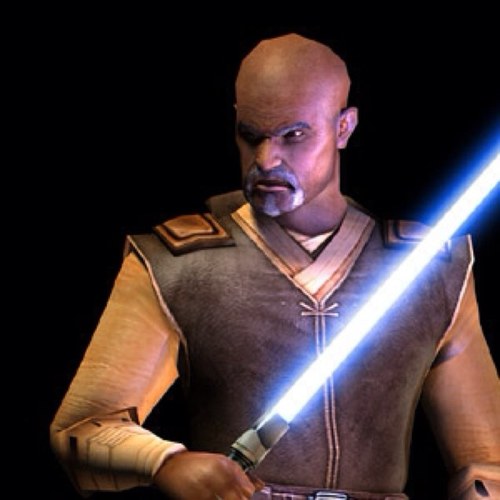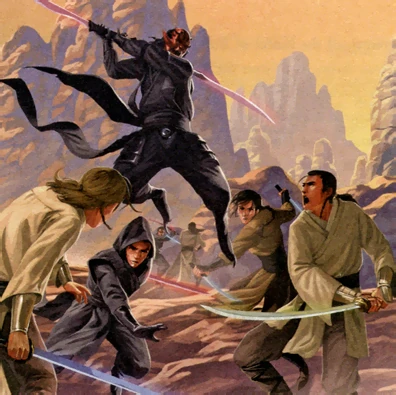One of my periodic Wiki Walks through the amazing
Wookieepedia has led me to consider the many similarities between the concept of the
Force in Star Wars (and Jedi and Sith views on it) and many
philosophies and religions of Eastern Asia. Now, it is no secret that George
Lucas drew heavily from the Chinese concepts of qi and dao[1] and
from the Japanese swordfighting martial art of Kendō, and many have already pointed out
the similarities between the old Jedi Order and Buddhist monks or between dao and the Force as concepts. Many interesting articles on the matter already exist on the internet; I would like however to try to
further analyse the differences between the two, and to share a couple of
reflections of mine on the subject.
 |
| Image taken from http://www.coffeewithkenobi.com/the-dao-of-star-wars-a-guest-blog-by-joshua-whitson/ |
In dao, the
opposing principles of Yin and Yang aren’t given any ethical connotation of
“good” and “evil”: each implies the other (in its symbol, the black portion contains a single white dot and vice versa), and both are necessary. In the Star Wars films,
however, the Light Side and the Dark Side are clearly principles of Good and
Evil, in a manner which may remind of Manichean or Zoroastrian ideas. Followers
of the Dark Side see the Force as a means to an end, their own power and fulfilment
(«Through passion,
I gain strength / Through strength, I gain power / Through power, I gain
victory / Through victory, my chains are broken»[2]),
while followers of the Light Side consider the Force its own end, and seek greater
knowledge and inner emotional detachment in order to guide the Galaxy to peace.
Indeed, most followers of the Light Side refer to it simply as “The Force”, and
consider the Dark Side something entirely different: in this view, the Light
Side is merely the Force’s natural state, a naturally flowing soothing river,
and the Dark Side is its corrupted form, a burning fire of pure power, and
keeping “balance” in the Force simply means eradicating the Dark Side. This is
the most common view in the old Jedi Order, backed by the fact that its
precursors did discover the Dark Side long after
discovering the Force itself, and may be more akin to Buddhism than Daoism:
avoidance of selfishness, extremisms, passion, personal possessions, and worldly
cravings (taṇhā), while leading a monk-like life of compassion towards every living being
in order to stop suffering (dukkha)
and break out of the karmic cycle of death and rebirth (saṃsāra). The two philosophies are
very far from being the same thing, of course, but some similarities do appear.
However, this view was not
universal: some, like Darth Krayt and perhaps Darth Plagueis, treat the
two sides as semi-sentient entities with purposeful designs, each using their wielders as tools, despite being parts of a whole. In some Expanded Universe stories
there are planets and races that are described as being naturally rich with the Dark Side (i.e. the
Masassi, the Rakata, the original Sith), but even parts of the canon material seem to be close to this interpretation. Yoda and Luke fight and reject the "dark side" within themselves as if it were an enemy actively trying to subdue them, the "temptation of a devil", but they do not consider it a part that needs to exist for there to be balance. This view may be more similar to
Zoroastrian or even Christian concepts.
Others, like the followers of the Unifying Force (including Darth Sidious), the followers of the unorthodox Potentium view, the Gray Jedi (like Jolee Bindo), and some members of the New Jedi Order (like Kyle Katarn and Mara Jade), view the Force as a neutral power that takes no sides: the potential for Dark Side and Light Side lay in the users, not in the Force itself. Hence why Jedi like Jolee Bindo and Kyle Katarn had no qualms about using Force powers traditionally associated with the Dark Side, and Mace Windu used an aggressive lightsaber style many deemed too close to the Dark Side, as they believed that only the intent of the user mattered. Some powers just happen to be of more use to, shall we say, "the light", while others were more frequently of use to "the dark". Despite some aspects of the Living Force view resembling Daoist thought[3], this might be the interpretation that gets closer to that of dao: an all-encompassing lifeforce that simply is, with no intent or ethic.
 |
| «The capacity for good or evil, like the Force itself, is in all living creatures. And belonging to the Jedi Order, or the Sith, or any group, won't change who you are at your core.» |
In my opinion, the most
comprehensive, convincing, and interesting interpretation of the Force lies just between the concepts of dao and qi: an all-encompassing energy that
exists in and between every living and non-living thing in the universe, and that
can be manipulated by individuals with varying degrees of prowess to cause many different effects for many different purposes (much like qi or ki or prana); that also exists as an
all-encompassing non-sentient essence of the universe itself, the deepest nature
of the Galaxy, that naturally moves towards its own balance and harmony; with no
ethically distinct sides, or perhaps with the Dark and Light Side merely representing
two different principles much like yin and
yang (passion and compassion, life
and intelligence, conflict and peace, creation and stability) that gain an
ethical connotation only through the intent of their users.
How to explain, then, the countless
conflicts between Jedi and Sith, Light and Dark, religious wars that have
scarred the Galaxy for over 30.000 years? Perhaps this is, again, but
the natural way in which the Force moves towards balance,
as the wind naturally blows between a high air pressure area and a low air pressure
area: whenever there is an umbalance in the Force, caused by the actions of Force
users trying to force their will upon the universe, war is the physical effect
of this natural movement towards a state of equilibrium. This is, again, pretty close to Daoist views. In my opinion, there is no reason to believe that the wars between Light Side and Dark Side followers are proof of the two sides actually being distinct entities with distinct intentions.
After all, no religious war is ever truly only about religion: a religion isn’t something as simple as ticking the box of whichever god(s) one chooses to worship, and it is quite childish to believe so. Religion is the symbol and spearhead of a society’s (or an individual's) whole system of beliefs in the fields of ethics, human rights, philosophy, ecology, economy, history, science, progress, interests, culture, and so on; therefore a religious war is a clash between ways of life, ways of seeing and interpreting the universe, ways of deciding how civilisation should progress. A religious war is but one of the many, many ways humans display their arrogance and presumptuousness in identifying those who are similar to them, identifying who are “the others”, and believing that their way and only their way is right, sensible, rational, and ethical. Paradoxically, it’s the same arrogance and presumptuousness so proudly displayed by a very large part of the internet atheist community, and I find it so ironical that they don’t seem to realise how much their contempt for religion makes them similar to the religious extremists that they so despise, but that’s a rant for another time.
 |
| The Force Wars, which took place over 25,000 years before the Battle of Yavin, were the first conflict between Light Side and Dark Side followers. Image taken from Wookieepedia. |
After all, no religious war is ever truly only about religion: a religion isn’t something as simple as ticking the box of whichever god(s) one chooses to worship, and it is quite childish to believe so. Religion is the symbol and spearhead of a society’s (or an individual's) whole system of beliefs in the fields of ethics, human rights, philosophy, ecology, economy, history, science, progress, interests, culture, and so on; therefore a religious war is a clash between ways of life, ways of seeing and interpreting the universe, ways of deciding how civilisation should progress. A religious war is but one of the many, many ways humans display their arrogance and presumptuousness in identifying those who are similar to them, identifying who are “the others”, and believing that their way and only their way is right, sensible, rational, and ethical. Paradoxically, it’s the same arrogance and presumptuousness so proudly displayed by a very large part of the internet atheist community, and I find it so ironical that they don’t seem to realise how much their contempt for religion makes them similar to the religious extremists that they so despise, but that’s a rant for another time.
The
difficulty one finds in pinning down any one real-world philosophy or religion
as the equivalent of any single view of the Force, is testimony of both the
immense potential for historical and philosophical depth in the
Star Wars universe (a potential that is, in my opinion, unmatched by any
fictional universe in modern history, save maybe for Tolkien’s
Arda), and the sheer amount of works and authors that have tried to expand its
spiritual aspect much beyond what little had transpired in the films. Even at the cost of producing pieces of fiction that contradict both each other
and George Lucas’s original (and mostly unexpressed) vision.
[1] I’m using the Pinyin transliteration system for
Chinese terms, therefore “dao” is to
be pronounced with a [t] (voiceless unaspirated alveolar occlusive) despite the
use of the graph “d”, and "qi" is to be pronounced with a [tɕʰ] (aspirated voiceless alveo-palatal affricate).
[2] Code of the Sith, as first appeared
in Star Wars: Knights of the Old Republic; in-universe, it was written by Sorzus
Syn in 6900 BBY. Conflict, the opposite of
peace, is seen as a source of progress. One might note that some of the views expressed by the Sith throughout
the ages are not too dissimilar from LaVeyan Satanism, and others bear a
striking resemblance to principles contained in Hitler’s Mein Kampf.
[3] As far as I know, no orthodox view
of the Force among the Jedi or Sith embraces the concept of wu wei (non-action or
non-effort) that is so fundamental in
Daoism: acting without
forcing one’s will upon the universe and its natural course, but instead acting
in accordance with its natural harmony. It’s the well-known concept of
“being like water”: when one’s actions are in complete harmony with the way of
things, they will come naturally and effortlessly). All Jedi taught instead that it was their duty to use the Force to protect others.
However, the believers of the Potentium thought that the Dark Side was a
“perversion” of the Force twisted by the selfish will of its users, and that
the Jedi were not needed to fight evil as long as every action was conducted
with moral intent; despite its ethical connotation, this view is closer to wu wei.
Nessun commento:
Posta un commento